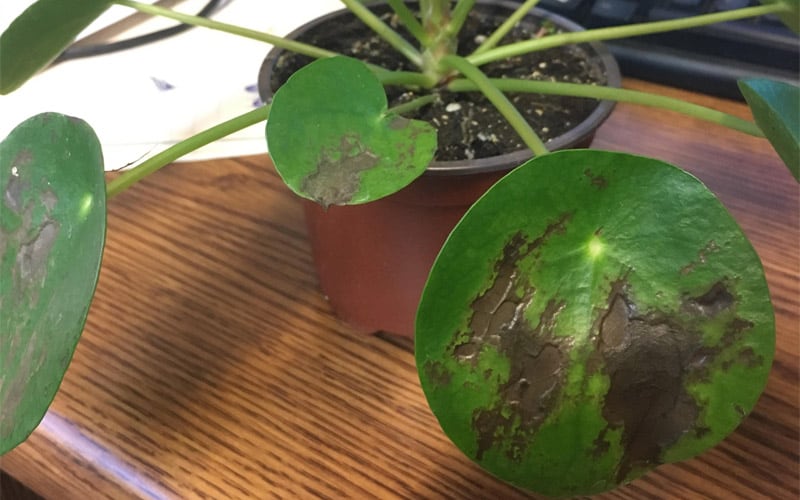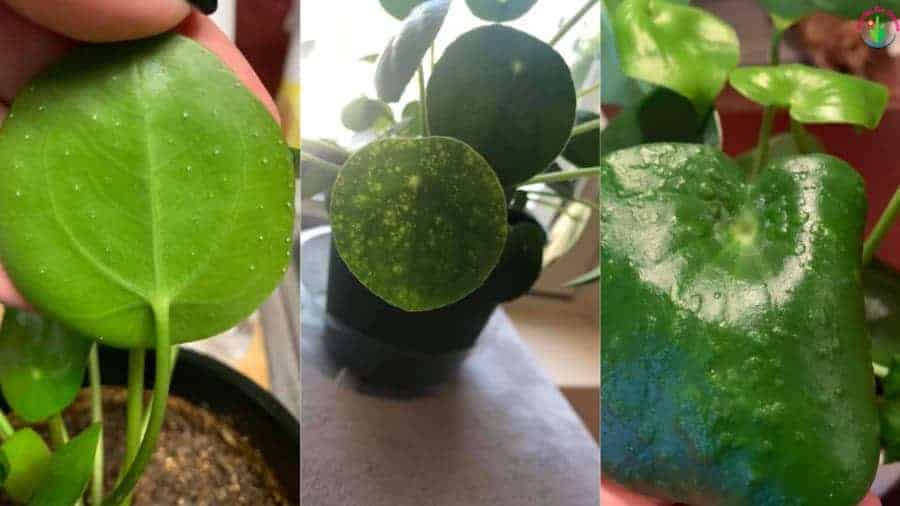Pilea peperomioides is an evergreen, erect perennial. It is native to Yunnan and Sichuan provinces in southern China. The plant has round, dark green leaves and is up to 4 inches (10 cm) in diameter. This plant grows to about 12 inches (30 cm) tall and wide in the wild and can grow taller indoors.
Many people love to grow Pilea peperomioides in the home or office because of their unique and strange beauty. However, like most ornamental plants, this plant also has many pest problems.
One of the most common diseases is the appearance of white spots, yellow spots, and black spots on the Pilea. They are all warning signs of care or environmental problems. Join us to learn more about the black spot phenomenon on Pilea to find a way to fix it.
What Causes Black Spots On Pilea?
There are many causes for Pilea peperomioides to have white, yellow, or black spots on the leaves. In general, they all stem from the same causes and have common solutions. Some of the underlying causes are waterlogging, lack of light, pests, or improper watering.
Edema Disease
Edema is one of the common reasons why black and white spots appear on the leaves of Pilea. The cause of this phenomenon is excessive watering and lack of light.
The basic symptoms that you can observe are the first white spots appearing on the leaves. If this problem is not detected and treated in time, the white spots will turn into yellow spots and black spots. The reason is that the leaf tissue is necrotic and gradually dies, dying away.
Excessive watering will cause waterlogging, causing the root system to transport too much water to all parts of the Pilea tree. The pores will become clogged, from which scabs and white spots begin to appear.
How to solve it?
- Stop watering immediately.
- Move the pot to an area with indirect sunlight, do not place the pot in direct sunlight to make the soil dry faster.
- Stimulate excess water to drain out the vent.
- Only water again when the ground is 1-2 inches dry, 1-2 times/week.
- Do not place the Pilea pot on a tray or dish containing excess water as it can easily cause waterlogging.
White Films Appear Due To Spores Of Fungi And Pests
You may spot a white, yellow, or black film covering the leaves, stems, or roots of the Pilea plant. They may appear on a few leaves, then spread to other leaves and the entire plant.
It is a phenomenon in which airborne fungal and bacterial spores attack the leaves. If you do not clean the leaves regularly, they will spread quickly and attack the tissue cells, causing the leaves to wilt and die.

How to solve it?
- Use a damp cloth to wipe off the white, yellow, or black film on the leaves.
- Remove damaged and severe leaves.
- Isolate the Pilea pot from other ornamental plants to avoid spreading.
- Make sure to place the pot in a well-ventilated location to limit fungal spores.
- Provide adequate indirect sunlight to dry leaves as bacteria and fungi thrive in moist environments.
Too Much Light
Light is one of the most important factors for plants. Pilea plants also need light for photosynthesis, growth, and development. However, this plant prefers indirect sunlight instead of direct sunlight.
If you place the potted Pilea in direct sunlight for many days, the plant will get sunburned. From there, black spots will appear on the leaves, the leaves will wilt and curl.
How to solve it?
- Move the potted Pilea to a cool location and out of direct sunlight.
- In the early days, you choose a location with lots of shade. Then, when the Pilea plants show signs of being fresh again, place them in a spot of indirect sunlight every day.
- West or Northwest-facing windows are an ideal location.
Extreme Temperatures
As you know, Pilea is native to the southern regions of China. Therefore, the ideal temperature for this plant to grow and develop well is between 60 and 80 degrees F (15 to 30 degrees C).
Some signs of a Pilea plant heat shock include black spots appearing, and curled or wilted leaves. They are signs that temperatures that are too hot or too cold cause the cell structure of the Pilea leaf to break down and be damaged.
How to solve it?
- You need to make sure to maintain the ideal temperature for your Pilea tree during the different seasons.
- Use a thermometer to measure the temperature and move the pot to locations where the ideal temperature is.
- In winter, locations near a fireplace will help prevent Pilea from freezing and freezing.
- In the summer, you can put them in cool and well-ventilated places.
Destructive Pests
Pilea plants will also be attacked by insects when experiencing health problems due to thinning of the cuticle. Thrips and aphids are two types of insects that often attack the Pilea tree. Bed bugs are small and white while thrips are black and small.
However, they can be destroyed in the same way. Both of these insects attack the leaves of Pilea directly by sucking on the sap. Signs can be seen as round, black spots on the leaf surface.
These insects can attack the Pilea tree from a young age and in the nursery. Therefore, you need to check carefully before growing them indoors because pests can spread to other ornamental plants.
Another pest is the bloodsucking bug. They often hide in the petioles and trunks of trees, especially at the base of the tree. This type of bug looks like a green wart or wart.
How to solve it?
- Regularly clean the leaves and stems with a damp cloth.
- Use antibacterial soap or neem oil to clean the leaves in case the Pilea tree shows signs of seriousness.
- Cut off infected leaves and isolate them from other ornamental plants.
- For bloodsucking bugs, you can wipe the leaves with alcohol and alcohol.
Fungal Diseases
Many fungal diseases will also cause the leaves of the Pilea tree to appear with brown or black spots. The fungi will attack the leaves directly, then destroy the cells and cause them to die.
Gray mold (Botrytis): It is a common fungus found in house plants. However, it is not a common disease on Pilea trees. You can see it as a bull’s eye on old leaves.
White Mold (Saprophytic fungus): The hallmark of this fungus is the white membrane that covers the entire Pilea tree. This fungus will not kill the plant immediately, but it will spread quickly and attack other plants in your home.

How to solve it?
- You need to clean the Pilea tree regularly and keep it in a well-ventilated area because the fungus often grows in enclosed spaces.
- Water properly, and do not allow the potting soil to become waterlogged.
- Water early in the morning to give the plant time to dry out when it’s dark, and avoid moisture for fungal growth.
- Remove infected leaves and isolate them from other ornamental plants.
- Maintain ideal humidity from 40-50%, do not let the humidity be too high.
- Water only when the potting soil is dry and makes sure the vents are not clogged.
- Use a fungicide to kill the fungus.
Too Much Fertilizing
Over-fertilizing a Pilea plant can also cause white, yellow, or black spots to appear on the leaves or stems. This is because chemical salts in fertilizers, or from tap water, can clog pores (called stomata in plants).
How to solve it?
- Use liquid or slow-release fertilizers.
- Fertilize once per month from late spring to mid-autumn. During the colder months, stop fertilizing completely because the plant is already dormant.
- Do not use tap water and try to use rainwater or sterilized water to irrigate the plants.
Poor Air Circulation
Poor air circulation, stagnation, and lack of light are ideal environments for pests and fungi to grow. The most obvious sign you can see is white, brown, or black patches appearing on the leaves. Then they will spread quickly causing your Pilea tree to slowly die.
How to solve it?
- Open doors often or place potted plants in areas with good air circulation.
- Do not intermingle Pilea with too many other plants as they can reduce the ability of each other to circulate air.
Improper Watering
Improper watering is one of the most common problems that most of us are prone to make mistakes with. Usually, we often water more than the actual needs of plants. Watering too much or too little will also cause black spots to appear on leaves due to waterlogging.
How to solve it?
- Make sure the pot is always vented and drained.
- Water from top to bottom until water comes out of the drain hole.
- Do not water the leaves directly because the fungus prefers a moist environment.
- Water only when the soil surface is 1-2 inches dry.
- Reduce watering in winter because plants hibernate, so they don’t use much water.
- Water more when the growing season returns from spring.
- Use distilled or rainwater for irrigation instead of tap water.
Frost
Frost is one of the factors that can quickly kill your Pilea tree. If you live in an area with harsh winters, the Pilea tree won’t be the ideal plant. Places near windows or with frequent cold air will also cause this plant to die from the cold. Frost causes the plant’s cells to expand and then burst and the plant to die.
Signs are black soggy patches on leaves and leaf tips, followed by the withering of the rest of the plant. Frost will kill the young leaves and the top of the first plant.
How to solve it?
- It is very difficult to revive a Pilea tree that has died from frost, so protecting the tree is the best option.
- Plants can recover on their own if frost damage is mild.
- Move the potted plant to a warm location during the winter months.
- Avoid areas near windows and cold winds throughout the night.
Conclusion
Black spots appear on Pilea trees and can be caused by many causes such as edema disease, improper watering, pests, fungi, and excess or lack of light. In addition, it is also associated with fertilizer problems, frost, and temperature stress.
To overcome this situation, you need to regularly observe signs such as white film, yellow spots, and black spots on leaves to find remedies. Do not overwater, clean the leaves regularly, fertilize periodically and create the ideal habitat for the Pilea tree to grow healthy.